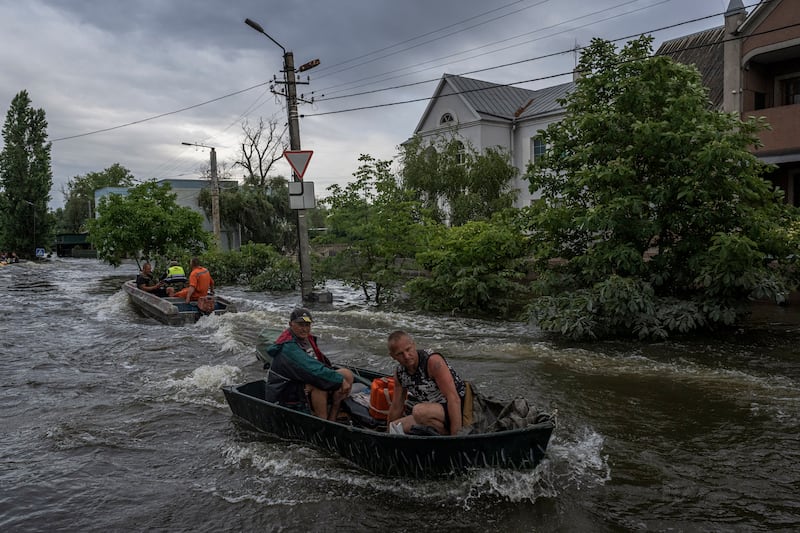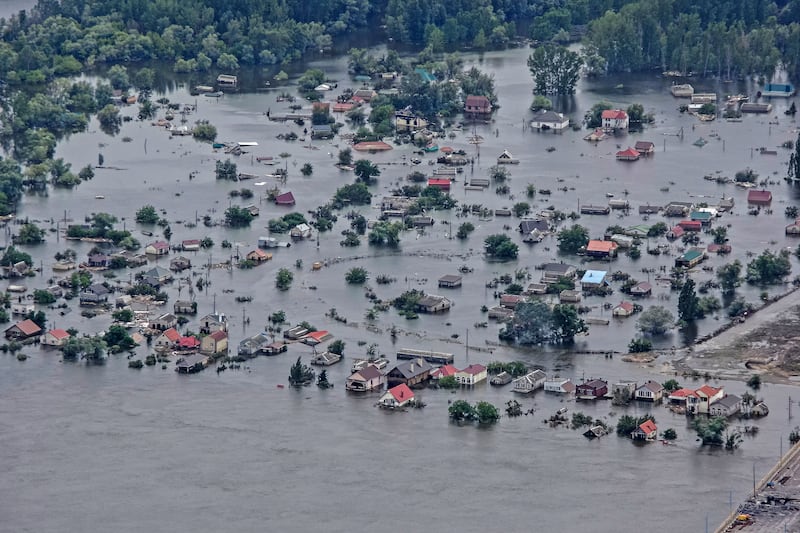Historian Valeriy Nefedov’s time as a soldier swept him into some of the fiercest battles of Ukraine’s war with Russia, but perhaps his most memorable mission took place just outside his home city of Zaporizhzhia.
A few weeks after the Russian-occupied Kakhovka dam exploded in June 2023, sending a deadly flood wave down the Dnipro river and draining the vast Kakhovka reservoir, Nefedov and a few comrades were given a singular and dangerous task.
“The general staff of Ukraine’s armed forces asked about five of us to explore what had been the bottom of the Kakhovka Sea,” he says, using the local name for a reservoir that covered some 2,000sq km – more than twice the size of Co Dublin – before the blast unleashed its 18 billion cubic metres of water.
“We were told to see what was happening on the dry riverbed, what processes were taking place and observe any artefacts that were there. It was quite difficult because we had to go out into no man’s land, between our positions and those of the enemy,” Nefedov says.
READ MORE
“But it was something fantastic, like a dream. This was terra incognita. I felt like the first person to arrive in an unknown land. This was the territory of the famous Great Meadow, which was described in ancient texts and legends. A territory that played a very important role since deep antiquity, from the Stone Age to our times.”
The Great Meadow – Velykyi Luh in Ukrainian – was a mythic landscape of forests, wooded islands, lakes, streams and swamps centred on the Dnipro river south of what is today the industrial city of Zaporizhzhia.
Nefedov – the head of the restoration department at a national reserve on Zaporizhzhia’s Khortytsia island – says that for centuries the Great Meadow was a verdant crossroads for people following the Dnipro to and from the Black Sea, and nomadic tribes crossing the Pontic Steppe that links central Asia and eastern Europe.
[ Ukraine floods: ‘First occupation and now this - it’s another nightmare’Opens in new window ]
It also sits at the core of Ukrainian national identity as the heartland of the Cossacks, a warrior caste that valued freedom and independence and whose self-rule had strong elements of democracy before it was abolished by the Russian Empire in the late 18th century – a history that resonates powerfully in the wartime Ukraine of today.


The Great Meadow vanished underwater in 1956, when the Soviet Union completed the Kakhovka dam and hydroelectric power station downriver and flooded the area, forcing tens of thousands of people to abandon dozens of doomed villages.
Russian troops seized the dam soon after launching their all-out invasion of Ukraine in February 2022, and subsequently operated it in an erratic way that caused large, sometime damaging, fluctuations of the water level along the Dnipro.
In the early hours of June 6th, 2023, seismic sensors and US satellites detected big explosions at the dam. Western experts say they were almost certainly triggered deep inside the Russian-controlled facility, but Moscow denies responsibility.
In the following hours and days, dozens of people were killed and tens of thousands displaced as water from the Kakhovka reservoir flooded large areas of Kherson and Mykolaiv regions on its way to the Black Sea. Upstream, around Zaporizhzhia, the vast store of water drained away, killing marine life and leaving farmland parched.

The full scale of the damage cannot be established because much the affected area is occupied, and the Dnipro river forms the front line in large parts of southeastern Ukraine, with Kyiv controlling the western bank and Russia holding the eastern shore.
Scientists say thousands of tonnes of fish died and large quantities of oil and other pollutants entered the Black Sea and contaminated flooded land and the drying bed of the reservoir, including heavy metals, fertilisers and pesticides accumulated over seven decades of industry and agriculture along the Dnipro.
Most expert predictions at the time ranged from the grim to the catastrophic – Zaporizhzhia and surrounding areas could face toxic dust storms, specialists said, as the poisoned river bottom became a desiccated dead zone where little or no life could survive.
“It could have been a desert. But that’s not what happened,” says Mykhailo Mulenko, head of nature protection at the Khortytsia national reserve.
“In just a month or two we saw things starting to grow, and by August 2023 there were willow trees sprouting in most of the reservoir. After about four months they were 1.5 metres high – so they were growing at twice the normal rate,” he adds.
“It turns out that this land is very good for them, with all the fertilisers that it contains. And these trees also absorb pesticides and other chemicals, fixing them and preventing them spreading further. They create a natural filter and barrier.”

Most of the dry reservoir is now covered with vegetation, including an increasingly diverse range of trees and dozens of types of grasses. But willow and poplar predominate – just as historical accounts say they did in the Great Meadow.
“Their seeds were carried here by the wind and birds and other animals,” Mulenko says, standing amid slender, four-metre-tall willows that are thriving on ground that was under three metres of water before the dam disaster.
‘It’s interesting: poplar and willow bear seed in late May and early June – they fly far and float on the water and when they settled on the old riverbed they started to grow. If the Russians had blown up the dam later in the summer, more invasive species would have taken hold. So it was a catastrophe – but in some ways we were lucky.”
Animal life is also returning: Mulenko and other scientists say fish including sturgeon have returned to spawn near Khortytsia island for the first time in decades, and foxes, badgers, deer, wild boar and even jackals now frequent the transformed riverscape.
In his office at Zaporizhzhia National University, Oleksandr Rylsky studies a map of the Great Meadow and Dnipro basin before the Kakhovka dam was built.

“There were very many lakes and streams and springs. Now the territory is starting to resemble this again. Over 70 years, sediment filled up a lot of these places, but the main streams are starting to push through. And the Dnipro has returned to its old course,” says Rylsky, head of the university’s department of general and applied ecology and zoology.
“The disaster killed 80 per cent of wildlife below the dam. Animals were drowned and washed away, the nests of birds were inundated.
“And ecologists thought the consequences would be very dangerous. I did too. But we were wrong. Now the area is almost entirely covered with trees, so even in very strong winds there won’t be dust storms. In some places, the levels of pesticides and heavy metals in the soil do exceed accepted norms – but only in certain areas.”
In the drizzle falling on Khortytsia island, small birds twitter among the young willows, a kestrel circles overhead and the Dnipro plies its new-old course in the misty distance. From the south, occasional muffled booms of artillery fire are reminders that the front line is only 30km away.
Malokaterynivka village is barely five kilometres from the fighting, and much of it has been badly damaged by Russian missiles, drones and guided bombs. Only about 150 of its 3,100 pre-war residents remain.

The head of Malokaterynivka, Lyudmyla Volyk, moved away in August after her house was hit for the fourth time, and now she works from an office in a southern suburb of Zaporizhzhia, organising aid and evacuation runs into the village.
“We had lots of dachas, shared allotments; people went fishing and enjoyed relaxing by the water. The reservoir was life ... Now that’s all gone,” she says.
“Some scientists say the Kakhovka reservoir is a great place for an eco-park of global significance. Honestly, I just want there to be water again, so people can have their dachas, come and relax, grow things in their gardens – it would be best to go back to how it was.”

For Nefedov, Mulenko, Rylsky and many others, the idea of rebuilding anything resembling the former dam is abhorrent. They believe Ukraine should look instead to the most modern methods of providing power and water for the region, while safeguarding and studying the extraordinary resurgence of the Great Meadow.
“Two crimes were already committed: the flooding of the Great Meadow, and then the destruction of the Kakhovka dam and the ecological catastrophe,” Nefedov says. “To flood this place again would be another crime.”




















